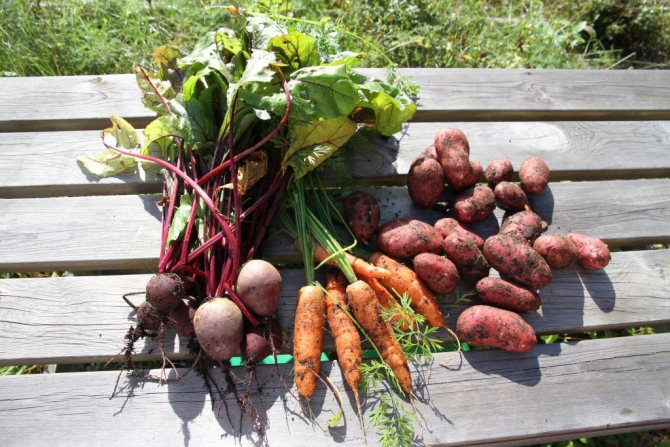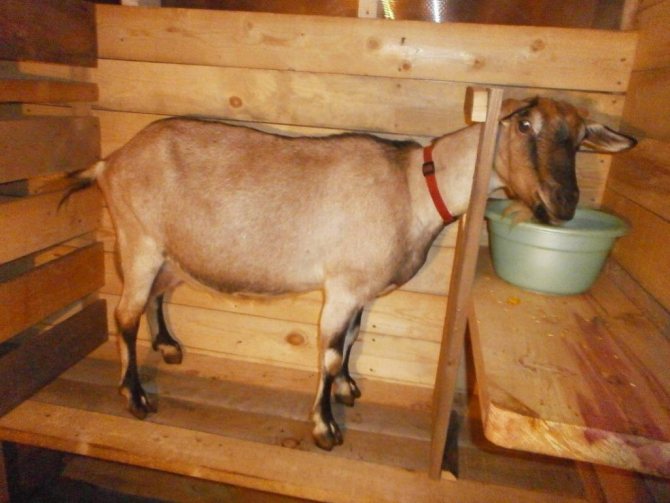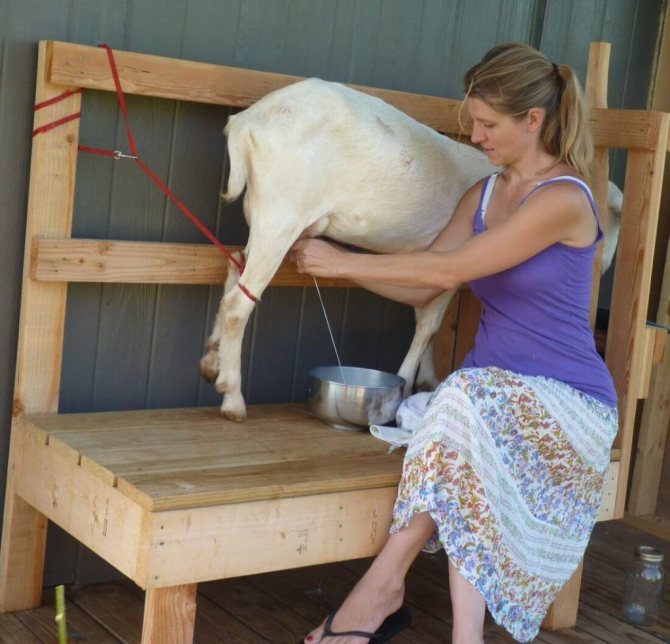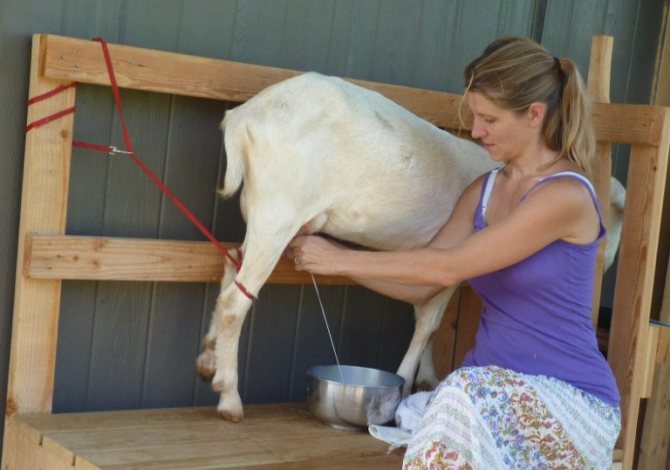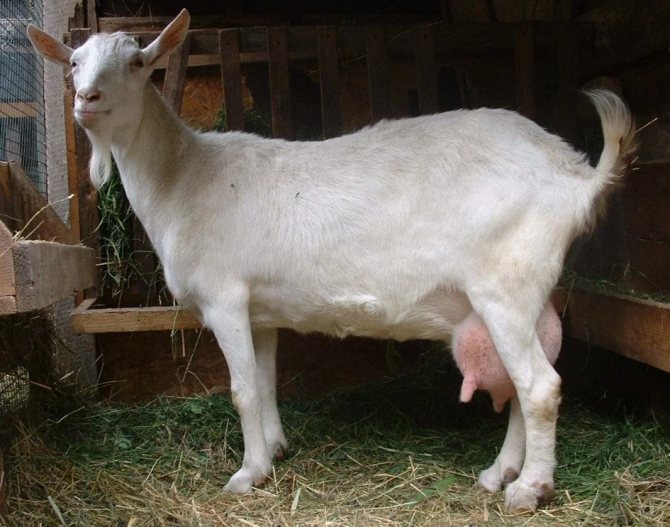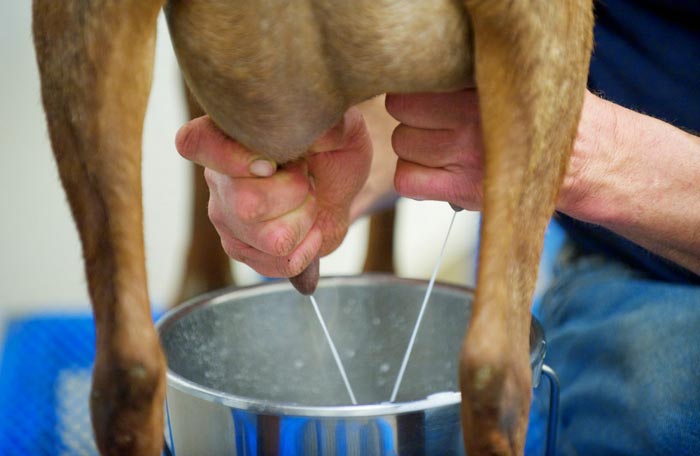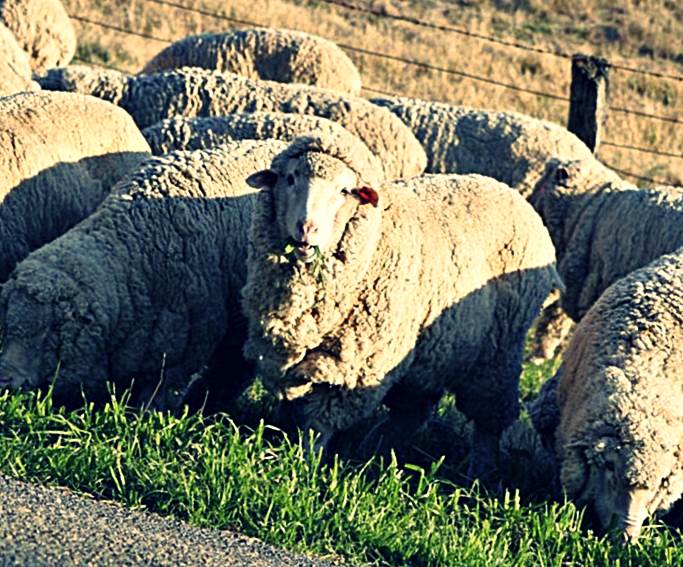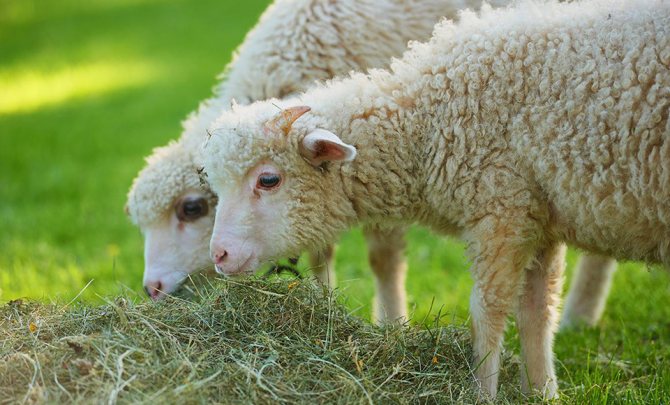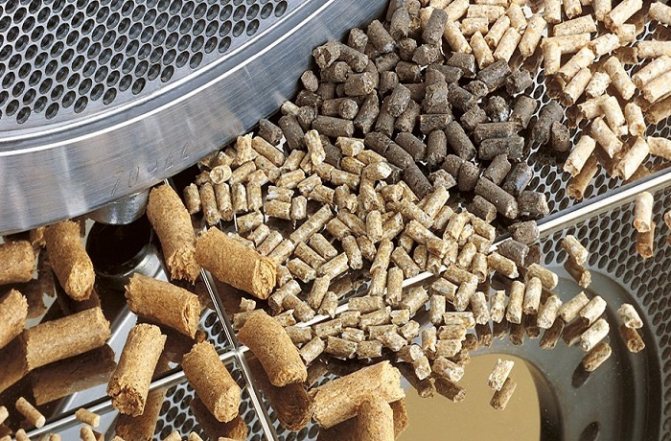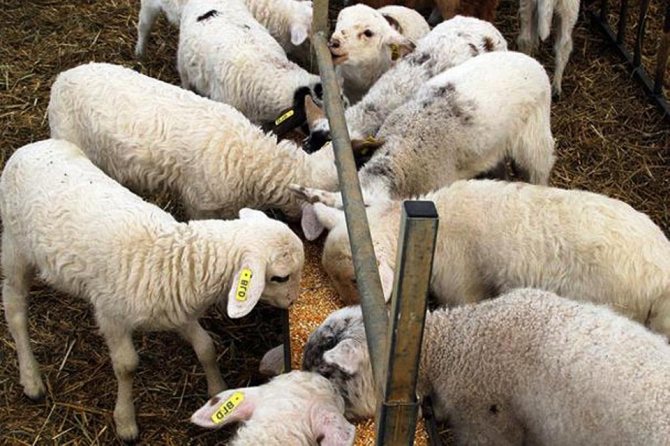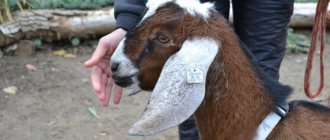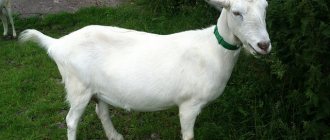
The goat has become a fashionable pet. Believe it or not, some families, vacationing in the summer at the dacha, even take these animals "for hire" in order to receive healthy and even medicinal milk. Many people buy goats to give a drink to their children. True, consumers always have many questions about the number of liters and usefulness, which we will try to answer in the article.
Average data on duration and value of milk production per year
There are three breeds of goats: some give milk, others are kept because of the beautiful soft wool, and from the third they get both.
| Breeds | Liters per day | Lactation days per year | Volume in liters per year |
| 1. Czech / mol. | 3,9–6,1 | 299–331 | 899–1201 |
| 2. Zaanenskaya / mol. | 4,8-5,1 | 298-301 | 899–1200 |
| 3. Alpine / mol. | 3,9-4,2 | 299–301 | 748–901 |
| 4. Nubian / mol. | 3,9-5,1 | 299-301 | 998-1000 |
| 5. La Mancha / Mol. | 3,1-5,1 | 298–301 | 899–1000 |
| 6. Russian / mol. | 2,4-2,7 | 238-342 | 401–599 |
| 7. Gorkovskaya / mol. | 2,9-3,2 | 249–299 | 499-501 |
| 8. Cameroon / Mol. | 1,4-2,2 | 148-151 | 198-202 |
| 9. Toggenburg / Mol. | 2,4-2,6 | 199–241 | 498-802 |
| 10. Megrelian / mol. | 0,9-2,1 | 179-182 | 101–250 |
It turns out that the goat gives a lot of milk per day. But you need to understand that if you take a kid into the farm, then you can get milk yield only after the first lambing. The table shows the average figures. And how much product you will receive, it will be clear when the pet lambes.
To increase milk yield, stimulation of lactation is needed even before the first pregnancy. To do this, massage the udder regularly. This will help the female quickly get used to milking and avoid stagnation in the future, respectively, mastitis. After the offspring are born, the milking process will quickly improve.
In households, small ruminants live up to fifteen years, but on average from eight to ten years. In a healthy livestock, milk yield grows up to five years, then growth slows down for two and a half / three years, and then goes down.
The ripening time for lambing is about five months. But the female is covered only by one and a half years. The fruit ripens for one hundred and fifty days. Accordingly, by the age of two of your pet, you can get milk.
Important
Do not expect that she will give it a lot - only about two liters per day, which will be completely spent on feeding the babies (six months). Maximum productivity begins after the female gives birth to the third offspring.
How much milk and what milk yield per goat per day, you can see in the table. A well-fed, well-groomed, well-prepared goat for milking every day (at the peak of lactation) gives the hostess 4.2-7.9 liters of an excellent product. That is enough for the kids, and the owners, and even for sale. And the amount of the product specifically for your pet will depend on many other circumstances, which we will consider in the article.
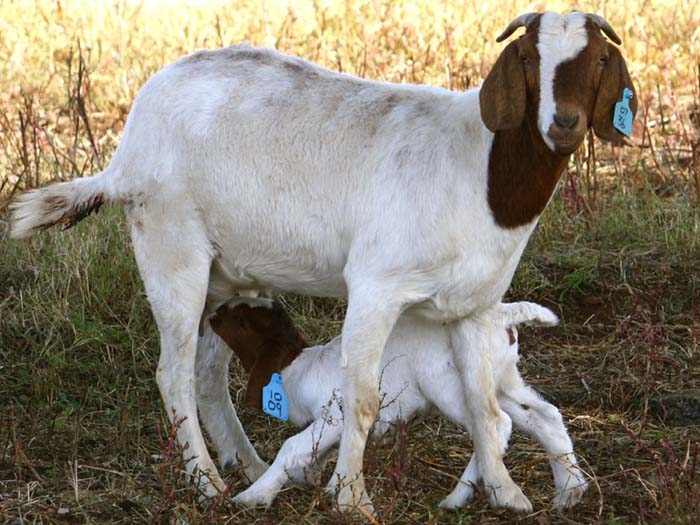

How many years do goats live
With an average life expectancy of animals of 10 years (rarely up to 16), the period of economic use is 8 years.
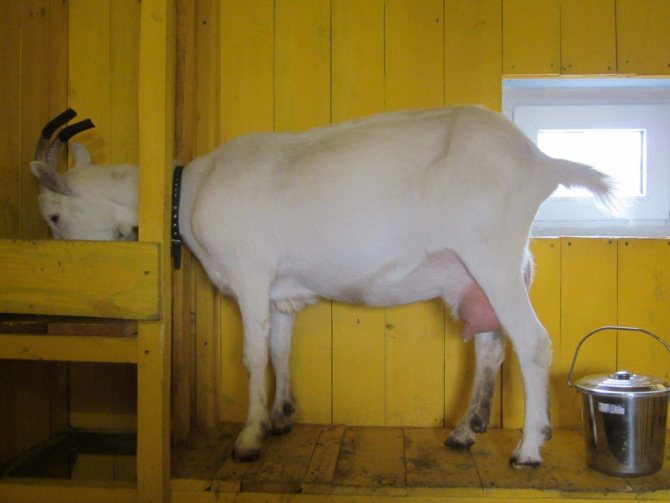

The better the conditions, the longer the goat lives.
With good care, proper conditions and proper nutrition, domestic goats live up to 14-15 years, but with their maximum use after 6-7 years, the productivity of animals decreases sharply. Until this age, the goat is profitable, its further maintenance becomes ineffective, since the same amount of feed is consumed, and the number of coverings and milk yield is much less.
At this age, it is better to slaughter it for meat before it is old and tough.
Important.You can start milking the animal after the birth of the offspring (the first mating is carried out in a year and a half). In dairy goats, milk production can last up to 11-12 months, while 7-9 - in others.
Dependence of the value of milk yield on the frequency of milking
The first factor affecting volumes is milking. Here is what experienced goat breeders advise: “A goat, like a soldier, must live according to a schedule. Accuracy must be maintained for up to five minutes. Milk must be collected at the set time, and milked three times. Try to "adjust" the female to your schedule. She will get used to it, and you will be comfortable. No need to be nervous and rush headlong to the milking. "
Preferably in late autumn and winter, milking twice, 12 hours apart. For example: at 07:00 and 19:00; at 8:00 and 20:00. In the spring-summer "run-up" between milking, reduce to eight hours, then the number of fences increases to three.
If the goat is young, then it is recommended to distribute four times with an interval of six hours. Then the alveoli in the udder tissue become well developed and the milk yield will grow.
If from spring to autumn the animals are in grazing, then twice (in the morning and in the evening) milk is obtained from them in the pens, in the daytime they are milked directly on the pasture.
The algorithm is as follows:
- The birth of kids is a fourfold milking.
- After milking - three times milking.
- Milk production began to decline - switching to milking twice a day.
The frequency of milking also depends on how much milk you get (goat milk yield per day). When in twenty-four hours it turns out up to two and a half liters, then "include" three times. If there is more dairy product, then two. The fact is that milking three times a day raises the volume by twenty percent.
How Do I Pick a Good Thrush?
The possible productivity of a goat can be judged by a number of external signs:
- Clear shiny eyes.
- Good dense coat.
- Smooth back.
- A barrel-shaped rounded belly.
- Straight legs set wide.
- Broad chest.
- Active, vigorous behavior.
- Good response to stimuli.
- Lack of horns.
- Rounded, not too fleshy and fatty udders.
Also regarding the udder, it is worth adding that a good sign is the acquisition of the udder after milking the folds and its slight sagging. Defects in the structure of the udder are: its sagging milking too sick or too small, directed in different directions, overly divided slices.
Existing milking techniques
Let's figure out for a start in instincts and reflexes. The goat sucks its mother, the goat substitutes its udder - this is an instinct. He is "born" with the animal. If you milk at the same hours, then by this time colostrum arrives at the goat - this is a reflex. The more the baby takes the drink - the more it is produced, similarly - the more often it comes to the udder, the more the mother is ready to give him this natural emulsion: nature has rewarded all mothers with this property at the metabolic level - this is not an instinct or a reflex, but features metabolic processes.
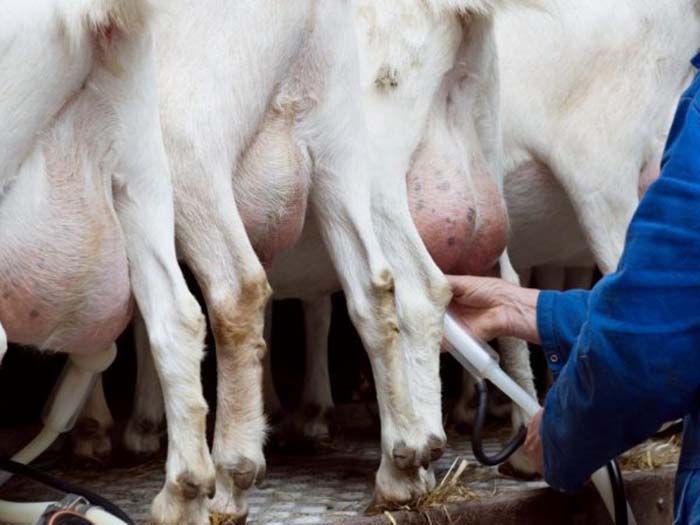

A thinking person, knowing these points, will understand how to organize milking in order to get the most useful product.
Milking rules:
- The udder should be washed with warm water before work. Then there will be no smell and no harmful microbes get in. If it's summer and the goat is grazing, some recommend washing the udder skin with deodorized soap twice and rinsing well.
- Wipe the washed area with a sterile tissue.
- The hind legs are locked. But not everyone does this, it depends on the habits and behavior of the female herself.
- Massage the udder, but without aromatic oils and smelling creams.
- The milking process begins.
On pasture, it is better to use a machine. Someone makes it on their own, someone orders. Sometimes you can find an industrial version.
There is a so-called "fist technique".This is when the nipples (each) are taken with the “thumb” and “forefinger”, pressed a couple of times until the drops are squeezed out, and then rhythmically with the rest of the fingers they “squeeze” the milk out of the udder.
There are a few mandatory rules:
- Milk to the last droplets.
- The process must be fast and continuous.
- Work calmly.
- After milking, do a massage.
- Wipe dry the skin of the gland with a sterile napkin.
- Lubricate each nipple with a special deodorized cream / ghee / petroleum jelly.
Some housewives believe that from time to time in the process of distribution it is necessary to use the pinching technique: the index and thumbs are involved. They press on the nipple at the place where it grows from the udder. Press two-three-four times, a white trickle appears. The first one is best expressed in a separate container.
This method is applicable when the goat has a small udder. If the gland is medium or large, then a combined technique is used that combines the use of both methods. Then the milk is removed faster and better.
The use of milking machines, especially in large farms, is beneficial and gives a good effect, especially when the goats are accustomed to them. And this happens gradually. Especially in combination with hand milking. But it is necessary to finish feeding each animal manually in order to completely empty the mammary gland.
Dairy goat breeds
Dairy goats are among the most ancient animals tamed by humans. For centuries, mankind has been working to improve the performance of a particular breed in general, and without the smell of milk in particular. These types are discussed below.
Russian white breed
The breed has been formed over several centuries by the method of popular selection. These goats are accustomed to the Russian climate, hardy and unpretentious. The most widespread are in the north-west and center of the country (Leningrad, Moscow, Yaroslavl, Ivanovo regions).
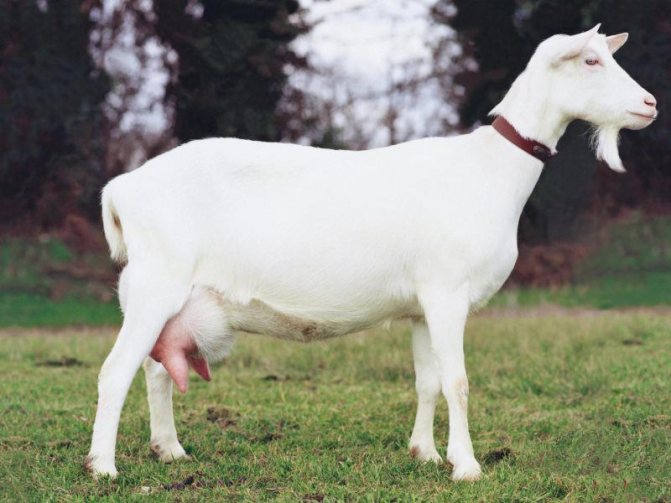

Russian white
The animals are well developed, large (goats - 60-70 kg, goats - 45-50 kg), with horns. They have a strong bone and a correct physique. White coat with almost no undercoat. From the skins, chevro and morocco are produced.
Gorky dairy breed
Active goats with short white-gray color without undercoat. Distributed in Ivanovo, Vladimir, Nizhny Novgorod regions.
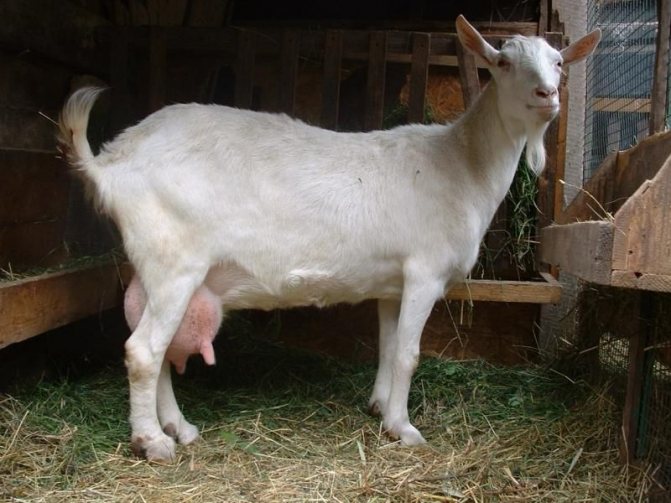

Gorkovskaya
They tolerate heat and cold well. The breed came from the Russian white. The weight of the goat reaches 70 kg, of the uterus - 65 kg.
Saanen goat
The breed was bred in Switzerland in the 19th century, appeared in Russia at the beginning of the 20th.
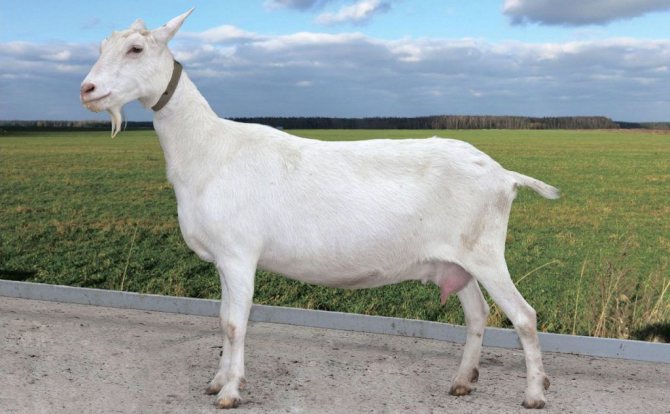

Zaanenskaya
Goats are white, without horns, short-haired. Goats weigh 60-83 kg, goats - 90-110 kg. Animals were used to breed new breed species, for example, Russian, Gorky.
Toggenburg
The breed from Switzerland took part in the creation of the British, Czech, noble and other breed species. In the Russian Federation, it is distributed in Altai, Kostroma, Leningrad, Vologda regions.
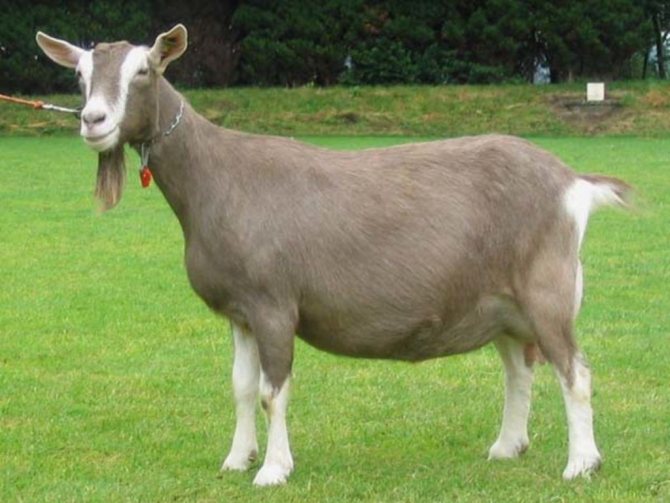

Toggenburg
Compact, peaceful animals weighing 45 kg goats and 60 kg goats with short brown hair with white spots. No horns, with a large udder. You can read more about the Toggenburg goat breed in our article.
Alpine
Hardy, adapted to cold weather and mountainous terrain, the breed is found on the territory of the former CIS countries.
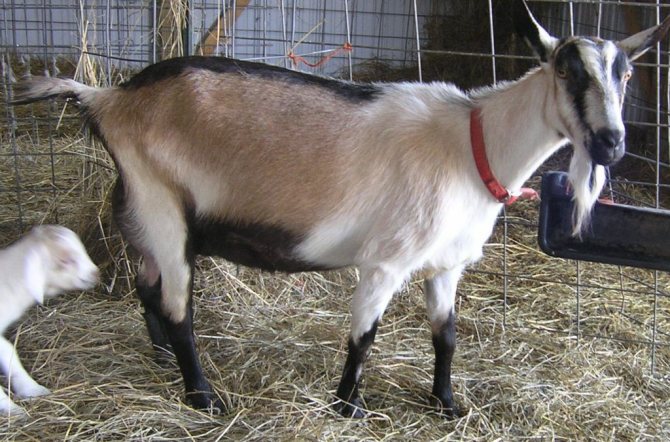

Alpine
Short wool of various colors - from white to black, sometimes two-colored. The average weight of animals is 75-80 kg.
Nubian
ears In Russia, the breed appeared recently - at the end of the 20th century. Long-eared animals with heavy brow ridges weigh 75 kg goats and 125 goats.


Nubian
They are distinguished by their stubborn and cocky character, restlessness and curiosity. Since they come from Africa and Asia, they are demanding for heat.
La Mancha
The breed was developed in Spain. Goats have very short ears, a well-developed udder, and a calm, affectionate disposition.
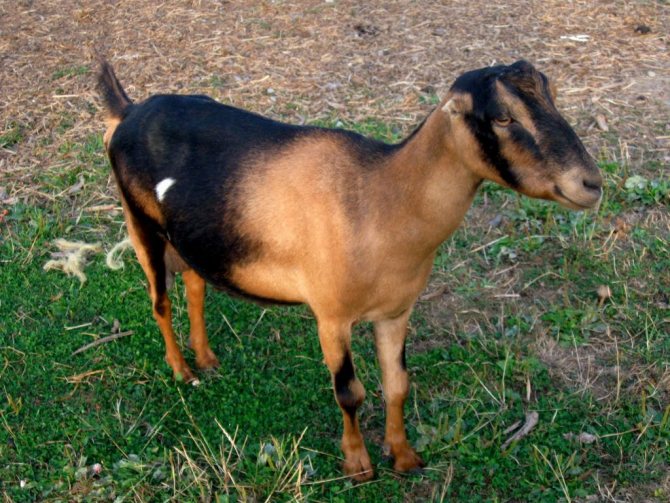

La Mancha
The weight of a goat is 65, a goat is 69 kg. Thick wool of various colors - brown, black, white, red, spotted.
Megrelian
The breed was developed by Georgian peasants in the first half of the 20th century. Goats are of lowland and mountain type.


Megrelian
They have crescent-shaped horns, coarse wool without undercoat of various colors - red-brown, roan, gray, white, mixed. The weight of a goat is 43 kg, a goat is 54 kg.
Hygiene and udder care rules
When the goat begins to give milk, you need to wash and wipe the udder. Let us dwell on this in more detail, including on the need and features of massage.
Hygiene rules should be followed strictly.
- The stall or pen where the animal is located must be perfectly clean.
- During lactation in females, the udder swells, the body is susceptible to infections, including mastitis. Cleanliness is essential.
- When a goat's udder is overgrown with wool, it must be cut - the hair can get into milk or carry pathogenic bacteria.
- The milking machine, or rather its parts, is sterilized before use or immediately after it has been used.
- It is imperative to boil water for washing the udder.
- The milkmaid's clothes are used constantly the same (this develops a reflex to the return of liquid), it must not only be clean - it is boiled if necessary.
- Napkins, wiping towels should be sterilized.
- Wash your hands twice with deodorized soap or wipe the bases of aromatic additives with an alcohol wipe.
- Massage treatments are required. They increase the volume of milk, prepare the udder for milking, and prevent mastitis.
Both halves of the gland are massaged in turn. First you need to rub it with your palms on all sides, first lifting it up a little and squeezing it slightly. Then lower it down and continue rubbing and repeat four to six times with each half of the gland. After that, proceed to milking, but lower the first milliliters into a separate vessel, not into a container with raw materials.
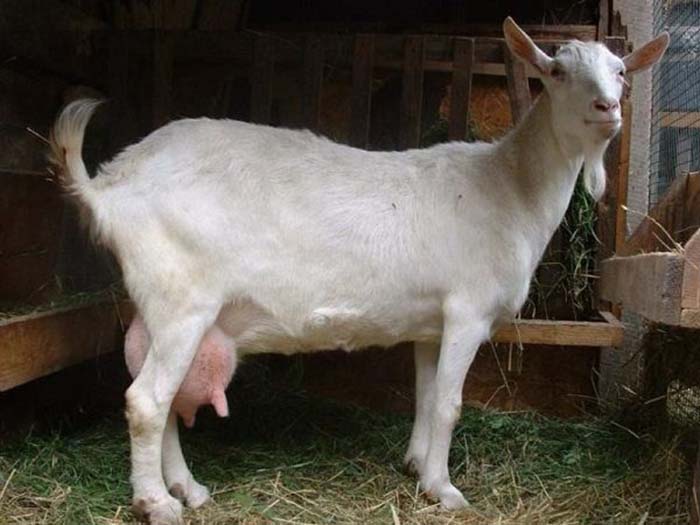

Interestingly, the mammary lobes in the goat are not reported. When young animals suck milk, it is released from the udder, and between feedings it accumulates in it. Moreover, in turn, the alveoli-ducts-cisterna accumulate in this order. When there is a lot of it, production stops. The emptying of the gland is a stimulus for the beginning of secretion. If you have not completely chosen milk, mastitis may begin.
Warming up the gland (washing with warm water and massage) improves the return of fluid.
Milk after the first lambing
The time when goats begin to give their first milk is after the first pregnancy. How much milk do you get from the primary flow? If the owner decided not to remove the kids from the mother, then milk for personal consumption can be donated only when the babies are 90 days old. At this time, they are removed from the goat and gradually begin to transfer from milk to normal food. The owner will receive about 1-1.8 liters of product per day from the first-flowering of an ordinary breed. It is possible to get 3-4 liters from highly productive young animals daily.
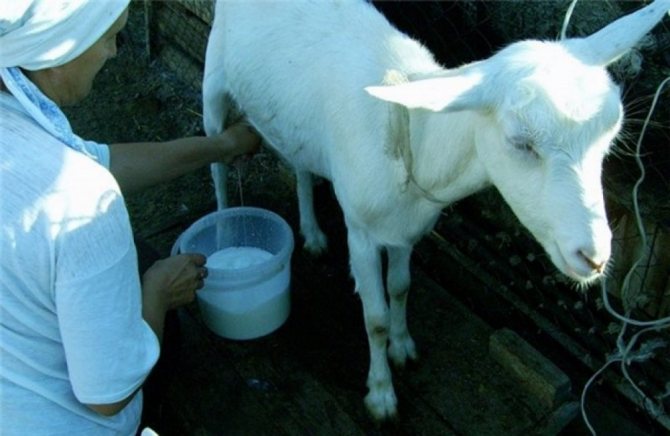

The time when goats begin to give their first milk is after the first pregnancy.
A similar situation will be observed in the event that the owner, after birth, transplanted the kids from the first heifer. The goat has no milk for the first week. Instead, colostrum is formed in the udder. This is a fatty mass that increases the immunity of the offspring. All colostrum must be donated and given to the kids. Further, within 1-3 months, most of the milk from the goat goes to feed the young.
Note! Only after three months they are transferred to succulent feed, grain and vegetable nutrition.
Milk-producing herbs
In order for the volume to grow, you need to properly arrange the feeding of the animal. In summer, when the goat is grazing, the place to graze should be carefully selected.
The meadow should be moist, but not swampy, and the grass should be fresh (not dry). Small ruminants love clover plots, eat grass with chamomile well, and are attracted to the lamb, horse sorrel. This must also be taken into account when feeding in stalls.
It is interesting
And remember that it is better to ask clover in a dried state - a fresh one sometimes leads to disturbances in the work of the digestive tract. In a shaded place, it is better to dry lamb and stinging nettles. These herbs enhance lactation, as do the branches of berry bushes, birch, apple, plum. It is beneficial to cook them for the winter.
Hay needs to be constantly renewed, and not filled up for several days: goats are selective, they look for tasty grass in it, they like to reach for it.
There are herbs that give a good increase in milk (parsley), but sometimes a not very pleasant shade of smell appears. When there is only one female on the farm, treat her to a handful of shelled walnuts. The fat content will increase, as will the milk yield.
Characteristics of Sheep Milk
Sheep milk has a rich chemical composition and contains a lot of substances useful for the human body. It is much fatter than cow and has a high calorie content, therefore it is practically not consumed fresh.
Did you know? Sheep have excellent memory, and newborn lambs can recognize their mother by voice.
The nutritional value of 100 g of sheep's milk is presented below:
- calorie content - 111 kcal;
- proteins - 5.6 g;
- fats - 7.7 g;
- carbohydrates - 4.8 g;
- water - 80.8 g;
- ash - 0.9 g.
In addition, the following components are present in the composition of sheep's milk:
- vitamins - A, B1, B2, B4, B5, B6, B9, B12, C, E, H, PP;
- macronutrients - calcium, magnesium, potassium, chlorine, phosphorus, sulfur, sodium;
- trace elements - iodine, iron, manganese, cobalt, copper, molybdenum, selenium, zinc, strontium;
- lactose;
- essential amino acids - arginine, valine, gimstidine, isoleucine, leucine, lysine, methionine, threonine, tryptophan, phenylalanine, tyrosine;
- nonessential amino acids - alanine, aspartic acid, glycine, glutamic acid, proline, serine, tyrosine, cysteine;
- saturated fatty acids - butyric, nylon, caprylic, capric, lauric, myristic, palmitic, stearic;
- monounsaturated fatty acids - myristoleic, palmitoleic, omega-9;
- polyunsaturated fatty acids - linoleic, arachidonic, omega-6.
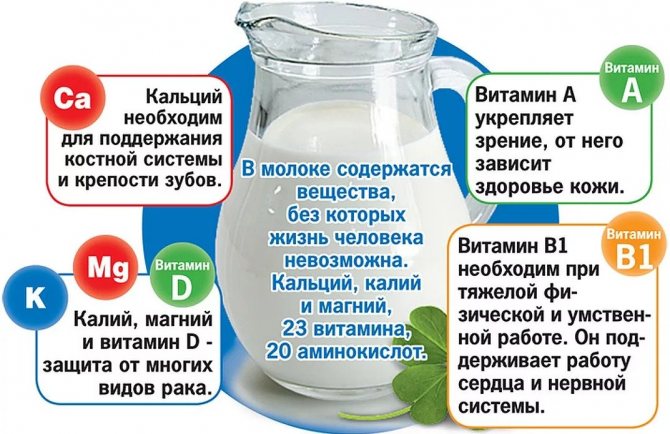

- Thanks to such a rich composition, sheep milk brings great benefits to the human body:
- strengthens bones and prevents the development of osteoporosis, rickets;
- promotes the recovery of the body after illnesses;
- increases the resistance of the immune system;
- prevents the development of cancer cells;
- helps fight insomnia;
- stimulates the activity of the brain;
- improves the condition of the skin and hair;
- has a beneficial effect on vision;
- effectively cleanses the body of toxins;
- helps fight anorexia;
- strengthens the heart and blood vessel walls;
- ensures the normal development of the fetus during pregnancy.
Important! The daily norm of sheep milk for an adult is no more than 150 g per day.
The "harmful" qualities of sheep's milk include:
- high fat content - the product should not be consumed by people suffering from overweight;
- the ability to cause an increase in blood cholesterol levels as a result of high fat content;
- irritant effect of the product on the gastric mucosa in the presence of gastritis or ulcers.
How to properly handle sheep milk
Sheep's milk differs from cow's milk in appearance, consistency and taste. Due to its high fat content, it is not consumed raw, but used for processing. The quality of the finished product depends on the correctness of this procedure, therefore, the processing of sheep milk should be carried out taking into account the following requirements:
- milk obtained after milking must be filtered through several layers of gauze, removing all unwanted impurities from it;
- if the product will not be processed immediately after milking, then it must be cooled to a temperature of + 10 ° C and placed in a dark place;
- during boiling, sugar must be added to a container with sheep's milk so that it does not curdle - 1 tsp will be required for 1 liter of liquid product. Sahara;
- to avoid the appearance of foams during heat treatment, you need to stir the milk often, and after boiling, immediately remove it from the heat;
- you can prevent the burning of sheep's milk by pre-rinsing the dishes in cold water;
- if the product is curdled, then it can be used to make curd.
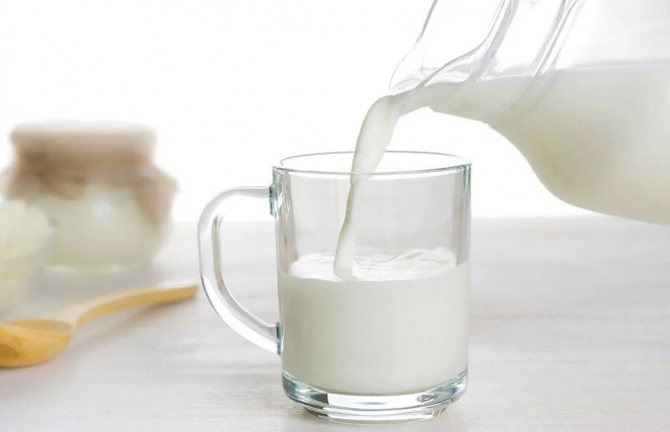

Methods to increase milk yield
The principle - more water - more milk, must be remembered! If the grazing area does not have a source of clean drinking fluid, the animal should be watered before walking. When kept in a stall, drink after absorbing hay. As you can see, how much milk a goat gives per day depends on you.
The lack of components of the mineral complex of the body leads to a decrease in the quality of milk. For females, special supplements are sold to compensate for micronutrient deficiencies. Which one to choose - consult with experienced goat breeders and veterinarians. Some people like to use for this purpose the so-called. "Salty (or salt) slimes", they promote the growth of hair, muscle mass and, importantly, milk yield.
You can't do without vitamins: both natural and special complexes are used as prescribed by a veterinarian. Fir and larch paws have long been advised to be used for feed additives. Bananas and banana peels work well.
It has been noticed that walking animals in the sun not only strengthens the future goat offspring, but also raises the level of milk yield.
Often in the veterinary clinic, goats are prescribed probiotics. They raise immune reserves, perfectly absorb feed and increase milk volume by almost twenty percent.
Some housewives say: "A goat is a horned dog." They become real girlfriends: they take offense or are drawn to the owners, they love affection, a calm, benevolent speech. Studies have shown that they react to attention to themselves with an increase of 4 meals. If you scream, the more you whip the animal, you will get little. Make sure that your pet in the common herd is not offended by other animals.
Goats are supporters of comfort. The ideal content is in a separate house, where in the cold season the temperature should be no lower than plus six degrees, and in the warm - no higher than eighteen Celsius. Warmth and absence of drafts, cleanliness and good food, affection and attentiveness are the main conditions for high productivity.
Approximate daily diet
If in the summer the goat is mainly fed on the pasture, and the green succulent grass practically covers the need for nutrients, then during the period of stall keeping, properly organized feeding plays a huge role. After all, a well-fed animal will never freeze, it will be cheerful, and a balanced diet will help maintain its health, and future offspring will be born strong and developed. Plus, this will have a positive effect on how much milk the goat gives per day.
In the morning, it is better to give the goat concentrates - 150 g or a little more for a large animal and half a kilogram of root crops per head.
At lunchtime, hay, wreaths or leaves will quench your hunger.
In the evening, there is the same amount of concentrated feed as in the morning. And more hay for the night.
If you do not follow the feeding norms, cattle may develop rickets and vitamin deficiency.
As evidenced by the decrease in milk yield
Remember how many months a goat is milked in a year? Three hundred! Even a pregnant goat can produce milk. If she has stopped, then sixty days before lambing, they start her up, start milking again.
When colostrum becomes smaller, it "signals" several points:
- Old specimen.
- The presence of a disease.
- Avitaminosis.
- Drinks little water.
- Poor feeding.
- Frightened, nervous.
- I entered the state of the hunt.
- Natural volume reduction before hunting.
- Change of feed.
- Helminthic invasion.
- Change of owner.
- Poor animal treatment.
There are many nuances. Therefore, always be attentive to your pets.
Alpine
This type of domestic animal was introduced from the United States. According to external prizes, it is characterized by a different coat color, has a straight muzzle, ears of medium size, which are set straight.
For many years, the distinctive feature of the Alpine goat breed has been its color, which distinguishes it from such breeds as the white Saanen and brown Toggenburg.
This type of goat is very productive. You can get up to 4 liters of milk per day, 1200-1600 liters per year. The fat content is 3.5%. This milk has a distinctive, pleasant taste.
As you have already noticed, each breed of goat has its own milk production. These characteristics are very important to know when you are going to have a pet. In addition, for each breed of goat, milk has its own taste, despite the fact that it is influenced by the feed used in the diet of the animal.
Tags: give, goat, milk, how much, day
About
«Previous post
Features of feeding from one week of age
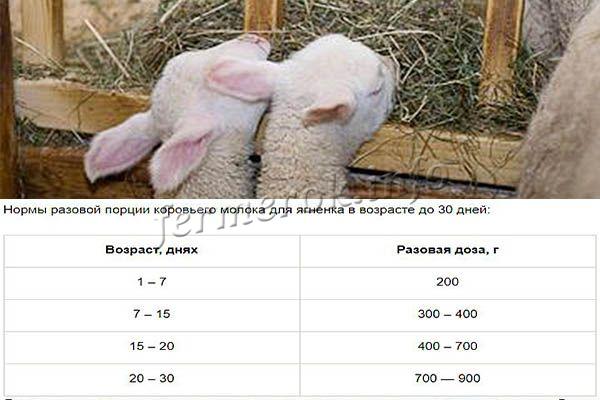

At 1 week of age, the lamb should be fed high quality hay.
From one week of age, in addition to mother's milk and additional feeding with cow's milk (if necessary), the lamb should be given high-quality hay. It is given in the amount that a lamb can eat - that is, without restrictions. It is the hay that allows the rumen in the lamb's stomach to develop properly.
Important!
Hay needs to be fed of high quality, because it is not very coarse, healthy and is quickly digested.
Mineral food does not interfere with a week or a maximum of 10 days of life. This includes chalk, salt, meat and bone meal. They contribute to the correct development of the skeleton, building up the muscle mass of the animal.
In order for the teeth to develop correctly, and the stomach to work without interruptions (diarrhea, constipation, frequent problems of lambs), you can gradually introduce twigs of willow, aspen, birch into the diet from the 10th day. They are soft, healthy, well absorbed, and contain a lot of nutrients.
Sheep milk products
Due to the fact that sheep's milk is denser and heavier than cow's milk, it is ideal for the production of cottage cheese and creamy yoghurt. But most often this product is the main ingredient for the preparation of hard and brine cheeses. They have a high fat content and rich creamy taste, and due to their low lactose content, they are easier for the stomach to digest.
Important! It is recommended to boil sheep's milk for no more than 3 minutes - otherwise it will lose all vitamins and nutrients in its composition.
Cheeses
Most types of cheese can be made from both sheep's and cow's milk. But there are several varieties of this product that are made exclusively from sheep milk. These cheeses have a special taste and useful chemical composition, due to which they are highly valued among consumers and have a higher cost.
The most common types of sheep milk cheese are listed below:
- Roquefort... The pulp of this cheese has an oily consistency, white color and characteristic nutty flavor, and inside it there are small cavities filled with precious blue mold. Outside, the product is covered with a shiny, moist white crust and exudes a mixture of sheep's milk and limestone aromas.


- Pecorino Romano... The product has a pungent taste with pronounced salty notes, and its flesh has a dense structure and is colored white-yellow. The outside of the cheese is covered with a light and smooth crust, and also exudes a rich aroma. It is used to prepare first courses, appetizers and salads, and is often served with honey as a dessert.
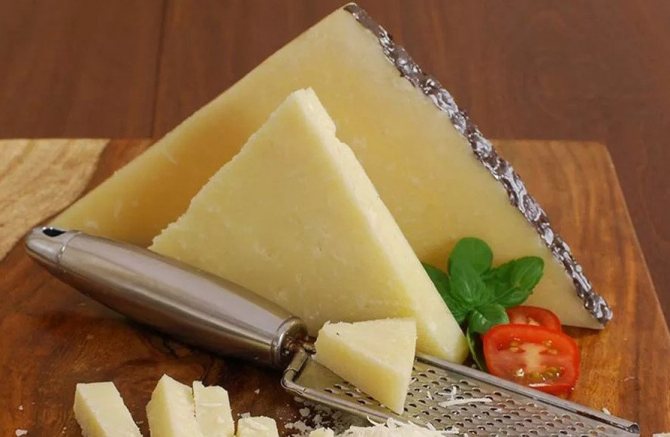

- Feta... Soft cheese that crumbles easily and has a sour-salty taste. The product is colored white, and its exposure requires at least 90 days. Feta should be stored exclusively in brine, since without liquid, its surface dries quickly, and the taste deteriorates. Used to prepare salads and cheese snacks.
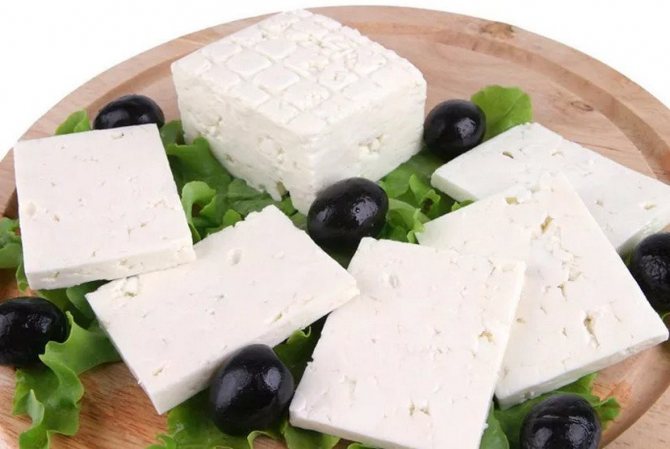

- Chanakh... This pickled cheese is a traditional product in Armenia and is made in special clay pots. The product has a "brittle" white or cream colored flesh with small cavities inside. The cheese lacks a crust, and its sour milk taste is characterized by characteristic spicy notes and a salty aftertaste with a slight bitterness. Used for making salads, snacks and khachapuri.
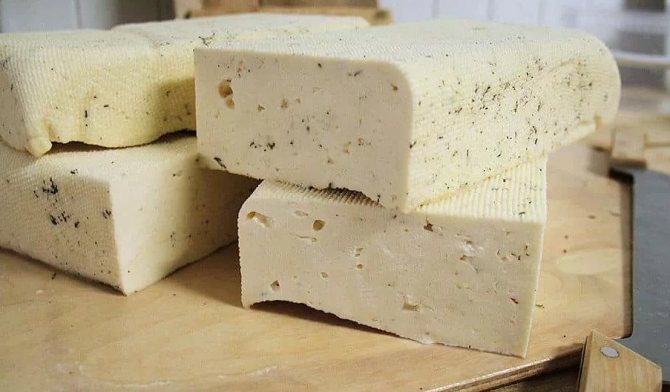

- Broccio... It is made in the form of a ball or flattened cylinder, covered with a thin layer of creamy mildew on the outside. The product has a rich pungent taste with pronounced sweet and salty notes. The pulp of the cheese is soft, has a creamy consistency and is colored white. The product is used as an ingredient in vegetable salads and can be added to soups and main courses.
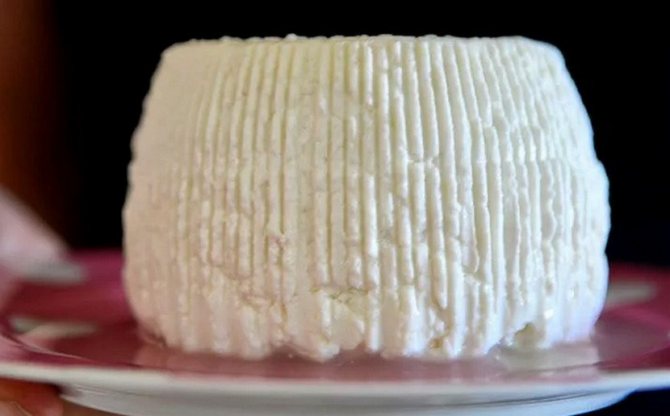

Cheese
The most famous sheep's milk cheese, which has a relatively low cost, is feta cheese... It can be used for cooking vegetables and meat dishes, snacks and soups, as well as filling for baked goods. Cheese is often used as an addition to tea, as it goes well with bread.
Did you know? For cutting Roquefort cheese, a special device was invented - a rock cutter. It uses wire as a blade, which helps to maintain the integrity of the soft mold heads in the pulp.
The main characteristics of feta cheese are presented below:
- the product has a moderately dense consistency, it breaks easily;
- the cheese is white;
- taste - fermented milk, with a characteristic salty flavor;
- the product exudes a pleasant sour aroma;
- the surface of the cheese does not have a crust, but a clear pattern from a fine mesh is visible on it;
- It is recommended to store the cheese in brine so that its surface does not dry out.
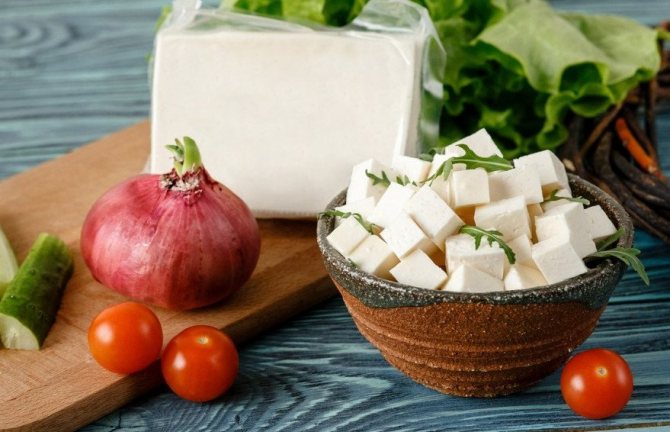

Thanks to its thick consistency and high fat content, sheep's milk is a valuable ingredient from which you can obtain nutritious and healthy dairy products. Using the recommendations listed above, you can choose the right breed of sheep to obtain this product, effectively milk animals, and use milk to produce delicious types of cheese.


